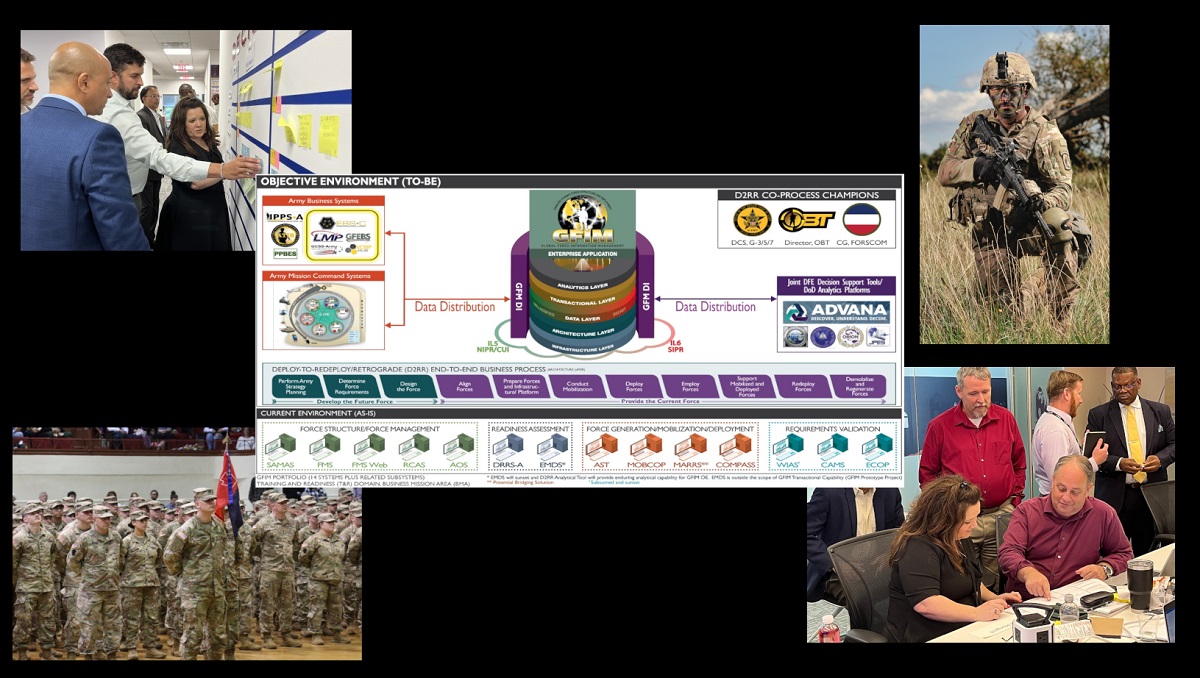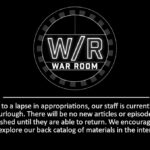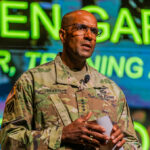
When faced with a challenge, a soldier will always come up with some sort of solution to make the system, process or piece of equipment work. It may not be an elegant solution or a good use of time, but they will find a way to make it work. Lori Mongold and Andrew St. Laurent are doing everything in their power to make sure soldiers don’t have to find workarounds to disconnected systems, at least in the force management world. They are the chief and deputy chief of the office in the Army staff charged with fixing how the service creates and manages units. Their solution revises processes and replaces fifteen legacy systems with one new information technology system, the Global Force Information Management Operational Environment. They join host Bob Bradford in the studio to explain the bureaucratic journey required to move the global force management process from the industrial to the cognitive era.
We’ll have a production ready capability later in FY 24…for the “design the force” and for the “providing of the current force”…and the entire GFIM application will be production ready no later than the beginning of ’25.
Podcast: Download
Subscribe: Apple Podcasts | Spotify | Amazon Music | Android | Pandora | iHeartRadio | Blubrry | Podchaser | Podcast Index | TuneIn | Deezer | Youtube Music | RSS | Subscribe to A Better Peace: The War Room Podcast
Lori Mongold currently serves as the Division Chief for the Strategic Operations Enterprise Division (DAMO-SOE) on the Army Staff, which is leading the service’s force management transformation effort. Through her innovative efforts, the Army’s global force management processes will move from the industrial to cognitive era. Lori has over 30 years of experience supporting Army program management, global force management, and readiness initiatives at the Pentagon, Joint Force headquarters, and Army Reserve.
Andrew St. Laurent currently serves as the Deputy Division Chief for DAMO-SOE. He previously served as Deputy Product Lead for Program Executive Office Enterprise Information Systems, Branch Chief for the Army Requirements Oversight Council at HQDA G8, and the Force Structure Division Chief at Army Cyber Command. Andy has deployed in support of Operations Iraqi Freedom and Enduring Freedom.
Bob Bradford is the Associate Professor of Defense and Joint Processes and Henry Stimson Chair of Military Studies at the U.S. Army War College and is in his seventh year on the Carlisle faculty. Bob served 30 years as an officer in the U.S. Army, the last 20 as an operations research analyst supporting enterprise decisions.
The views expressed in this presentation are those of the speakers and do not necessarily reflect those of the U.S. Army War College, U.S. Army, or Department of Defense.
Photo Description: Clockwise from top left: Lori Mongold, Division Chief, Headquarters, Department of the Army G-3/5/7 Management Office-Strategic Operations Enterprise, discusses ‘user stories’ – upcoming actions for development of the Global Force Information Management Objective Environment (GFIM OE) software with contractors from BigBear.ai at the program increment four planning meeting in Chantilly, Va., Aug. 15, 2023; U.S. Army Paratrooper, Specialist Adam R. Lesneski, a 13B Cannon Crew-Member, assigned to Second Platoon, Bull Battery, 4th Battalion, 319th Airborne Field Artillery Regiment, 173rd Airborne Brigade takes a knee in the fields of Grafenwoehr Training Area, Germany while supporting Exercise Iron Triangle 19, August 19, 2019.; Lori Mongold and Andrew St. Laurent (seated) during a GFIM working group meeting.; U.S. Soldiers with Headquarters and Headquarters Battalion, 28th Infantry Division, and their families are honored during a deployment ceremony at Zembo Shrine Auditorium. Center: GFIM OE Operational View
Photo Credit: Clockwise from top left: Francis “Frank” O’Brien, GFIM OE Capability Management Office; Sgt. Henry Villarama; Francis “Frank” O’Brien; Capt. Travis Mueller; Center: Enabling GFIM OE White Paper #2




At USCENTCOM serving in a supervisory role in all Global Force Management actions in and out of the Middle East, I wholeheartedly agree and strongly believe the enterprise can do better. Innovative initiatives and solutions are in motion at our headquarters including ADVANA, ORION, MAVEN, and VJOC. We are also excited about the JS GIDE experiment to generate a Digital SDOB. Thank you for clearly explaining the problem that exists in the down trace units at the point of the spear. Good luck with GFIM!
Soldiers’ determination and innovation shine through in the face of challenges, as demonstrated by Lori Mongold and Andrew St. Laurent’s efforts to streamline Army force management. Their transition to the Global Force Information Management Operational Environment marks a significant step towards a more efficient and effective military system. #InnovationInAction
Great Podcast – Bob Bradford, your speaking voice is excellent for Podcasting. I enjoyed the talk for Change Agent, Lori Mongold, Division Chief, Headquarters, Department of the Army G-3/5/7 Management Office-Strategic Operations. Listening to the discussion, I would have liked to have a location for possible slides or planned integration of systems. GFIM progression will be important to G-Army systems as total Army integration occurs. Several systems have now been integrated into GCSS-A Global Combat Support System to allow immediate financial returns for credits/cancellations for tactical units to best utilize funds. Will the changes in the financial reporting system integrate with GCSS-A and DLA systems for ordering and financial immediate accountability?